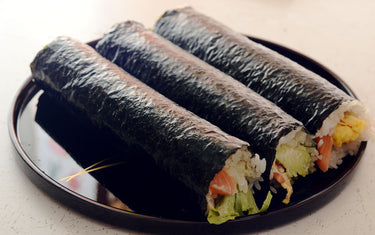In Japan, there is a custom of eating Eho-maki (uncut sushi rolls for good luck) on Setsubun (the last day of winter). Setsubun, a uniquely Japanese annual event, is a big event for children to look forward to.
In this article, we will introduce how to make and eat Eho-maki, a classic Setsubun dish!
The product we used:
What is Eho-maki?

Eho-maki is a thick sushi roll eaten on Setsubun.
Although the ingredients of Eho-maki are not much different from those of ordinary Futo-maki (thick sushi roll), there are various styles of eating for making a wish in different regions and some people eat thin sushi rolls or hand-rolled sushi.
The origin of Eho-maki is not known, but it is a relatively new custom that spreads rapidly in Japan after the 2000s.
How to eat Eho-maki
There are many ways to eat Eho-maki. The basic rule is "to eat it facing the direction of blessings".
The word "Eho" means the auspicious direction where the god of good fortune for the year exists and is also called "Kippou" or "Akinokata/Akihou". It is believed that eating Eho-maki facing Eho, the good luck direction of the year, will bring you good fortune.
Other standard rules are to keep quiet while eating the roll and to gulp it all at once without cutting it into bite-size pieces. There are also local rules such as eating while laughing, standing up, or with your eyes closed.
How to make Eho-maki
Now let's make Eho-maki.
You can make Eho-maki with any ingredients you like. It is common to use seven fillings related to Shichifukujin (seven lucky gods). The standard ingredients are kampyo (dried gourd), simmered shiitake mushrooms, thick Japanese omelette, sakura-denbu (pink-colored sweet fish flake), shrimp, cucumber, and eel. This time, we have the following lineup. Let's enjoy a variety of your favorite ingredients.
Fillings (for 3 rolls)

- Sushi (Vinegared) rice ...1.5 cups
- Nori (dried seaweed) ... 3 sheets
- Salmon
- Cucumber
- Crab stick (imitation crab)
- Thick Japanese omelette
- Sakura-denbu
- Avocado
- Simmered shiitake mushrooms
- Shiso (Japanese herb)
You can also use kamaboko (fish cakes), tuna, yellowtail, cod, flatfish, American catfish, tilapia (damselfish), and swordfish.

"Makisu" is used to make Eho-maki. Makisu is an ancient Japanese cooking utensil used mainly for forming sushi rolls into cylindrical shapes and for shaping Japanese omelettes.
Makisu is generally made of bamboo, which has high antibacterial properties. The plastic one is also useful for easy hygiene control. Please choose the size and color of your choice.
1. Vinegared rice

Make sushi rice in advance.
Pour sushi vinegar (a mixture of 3 tablespoons of rice vinegar, 2 tablespoons of sugar, and 1/2 teaspoon of salt, all not included in the quantity) over freshly cooked rice evenly. Mix with a rice scoop to avoid crushing the rice grains.
2. Vegetables

Cut cucumbers and shiso leaves into thin strips lengthwise. Please adjust the thickness of the vegetables as you like. Remove stems of shiitake mushrooms, slice, and cook with a seasoning mixture of soy sauce, sake, sugar, and water (all not listed).
3. Main fillings

Cut salmon and crab sticks into long and thin strips for easy rolling. When you use eel, conger eel, or tuna, cut them in the same way.
4. Sakura-denbu

Sakura-denbu is a kind of Tsukudani (preservable food boiled down in soy sauce) made by coloring fish meat in cherry color. They should be available in the food coloring or food colors section of your grocery store.
5. Thick omelette

Make a thick omelette and cut it into long, thin strips so that it is easy to roll up. It is convenient to use an omelette pan.
6. Place a nori on the Makisu

When all the fillings are ready, finally roll up Eho-maki. First, place a nori on the Makisu. The smooth side of the nori is the front and the rough side is the back. Please set it so that the smooth side is down.
7. Put sushi rice on the nori

Spread enough sushi rice to cover about 70% of the surface of the nori. This is an important process that determines the beautiful finish of Eho-maki. Please spread it out carefully and as evenly as possible.
8. Place the fillings on top

Arrange the ingredients in order from the front. The key is to line up the fillings without any gaps between them so that they stick to each other perfectly. Sprinkle plenty of mayonnaise on top of the fillings for a kid-friendly flavor.
9. Roll up with the Makisu

Roll up all the fillings at once, starting from the front, that is the secret to make the beautiful Eho-maki. If you hesitate it, you will not be able to roll it up neatly.
10. Shaping

As shown in the photo, hold the Makisu on the side you are rolling up and roll Eho-maki to the end. Finally, while wrapping it in the Makisu, gently turn it several times to shape it.
11. Eho-maki is ready

People would generally bite into a whole Eho-maki. If it is hard to eat, cut it into bite-size pieces with a knife.
Let's enjoy Setsubun with Eho-maki!
The auspicious Eho-maki will bring you good fortune. In addition, the refined taste of this traditional Japanese dish is also appealing.
Enjoy your own original Eho-maki by freely arranging the fillings of your choice!














